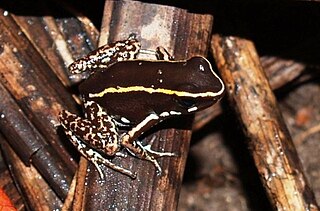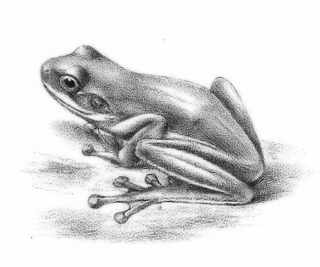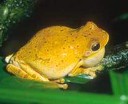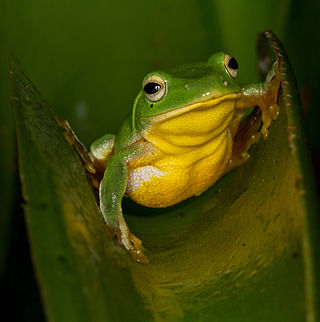Related Research Articles
Leucostethus argyrogaster or the Imaza rocket frog is a species of frog in the family Dendrobatidae. It is endemic to Peru.

Hyloxalus elachyhistus is a species of frog in the family Dendrobatidae. It is found in southern Ecuador and northern Peru, in the Huancabamba Depression and south to Cajabamba Province.

The Marañón poison frog is a species of frog of the family Dendrobatidae. It is endemic the Cordillera del Condor, in the upper Marañón River drainage, of Cajamarca Department, Perú.

Ranitomeya vanzolinii, also known as the Brazilian poison frog or spotted poison frog, is a species of frog in the Ranitomeya genus, from the poison dart frog family, Dendrobatidae. It is found in the Amazonian rainforests of Brazil and Perú, and possibly Bolivia.

The lovely poison frog or lovely poison-arrow frog is a species of frog in the family Dendrobatidae. It is found on the Caribbean versant of Central America from southeastern Nicaragua through Costa Rica to northwestern Panama, with one record just west of the Panama Canal. Populations from the Pacific versant, formerly included in this species, are now identified as Phyllobates vittatus.

The Golfodulcean poison frog or Golfodulcean poison-arrow frog is a species of frog in the family Dendrobatidae endemic to Costa Rica.

The Costa Rica brook frog or red-eyed stream frog is a species of frog in the family Hylidae found in Costa Rica and Panama. Its natural habitats are tropical moist lowland forests, subtropical or tropical moist montane forests, and rivers between 70 and 1740 meters above sea level.

The Manaus slender-legged tree frog, also known as the giant broad-headed tree frog, is a species of frog in the family Hylidae found in Bolivia, Brazil, Colombia, Ecuador, French Guiana, Guyana, Peru, Suriname, and Venezuela. Its natural habitats are subtropical or tropical dry forest, subtropical or tropical moist lowland forest, moist savanna, rivers, intermittent freshwater marshes, and canals and ditches. It is threatened by habitat loss. It is also reported to produce bufotenin.

The mahogany tree frog is a species of frog in the family Hylidae found in Belize, Costa Rica, Guatemala, Honduras, Mexico, and Nicaragua.

Triprion petasatus, Yucatán shovel-headed tree frog, Yucatan casque-headed tree frog, or Yucatan casquehead tree frog is a species of frog in the family Hylidae found in Belize, Guatemala, Honduras, and Mexico. Its natural habitats are subtropical or tropical dry forests, moist savanna, freshwater marshes, intermittent freshwater marshes, rural gardens, heavily degraded former forests, aquaculture ponds, and canals and ditches.

Taruga longinasus is a species of frog in the family Rhacophoridae. It is endemic to Sri Lanka. It has been observed between 150 and 1300 m above sea level.

The Taipei tree frog is a species of frog in the family Rhacophoridae. It is endemic to central and northern Taiwan. It is a medium-sized tree frog; females are 4.5–5.5 cm (1.8–2.2 in) in snout-vent length, and males are slightly smaller 3.5–4.5 cm (1.4–1.8 in).

Raorchestes dubois or the Koadaikanal bush frog is a species of frog in the family Rhacophoridae.

Dendrobatinae is the main subfamily of frogs in the family Dendrobatidae, the poison dart frogs of Central and South America, found from Nicaragua to the Amazon basin in Brazil.

Ranitomeya sirensis or the Sira poison frog is a species of poison dart frog found in the Amazonian rainforests of northern Bolivia, westernmost Brazil (Acre), and eastern Peru.

Ranitomeya summersi, sometimes referred to as Summers' poison frog, is a species of poison dart frogs found in the central Huallaga River drainage and adjacent Cordillera Azul National Park in central Peru. Before 2008, the species was considered a subspecies of Ranitomeya fantastica. The IUCN considers it an endangered species because of limited habitat range, habitat loss, and collection for the pet trade.
Hyloxalus aeruginosus is a species of poison dart frog endemic to Peru.
Hyloxalus craspedoceps is a species of frog in the family Dendrobatidae. It lives in Peru.
Hyloxalus eleutherodactylus is a species of frog in the family Dendrobatidae. It is endemic to Peru.
Hyloxalus insulatus is a species of frog in the family Dendrobatidae. It is endemic to Peru.
References
- ↑ Gregorio Moreno-Rueda; Mar Comas, eds. (2023). Evolutionary Ecology of Amphibians (Preview). CRC Press. ISBN 9781000909241 . Retrieved July 8, 2024.
- 1 2 Kip Green; Kellie Whittaker (February 11, 2005). Kellie Whittaker (ed.). "Phyllobates vittatus (Cope, 1893)". AmphibiaWeb. University of California, Berkeley. Retrieved July 8, 2024.
- ↑ Peera Chantasirivisal; David B. Wake; Ann T. Chang; Michelle S. Koo (October 25, 2005). Kellie Whittaker (ed.). "Hyalinobatrachium valerioi (Dunn, 1931)". AmphibiaWeb. University of California, Berkeley. Retrieved July 8, 2024.
- ↑ Mike Dorcas; Whit Gibbons (2011). Frogs: Ultimate Animal Answer Guide (Preview). Johns Hopkins University Press. p. 64. ISBN 9781421401188 . Retrieved July 8, 2024.